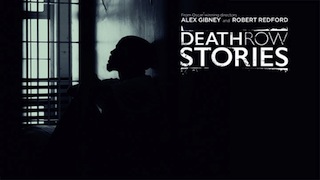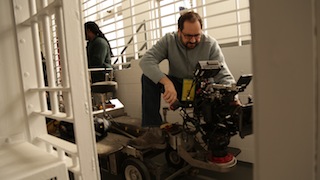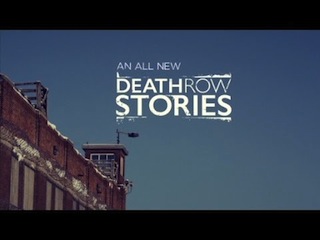 Director of photography Antonio Rossi used Canon cameras – and an assortment of Canon Cinema and EF-series lenses – to capture stylized, cinematic footage for Death Row Stories, an eight-part CNN Originals series about America’s most compelling capital murder cases. The series is executive produced by Robert Redford and Laura Michalchyshyn of Sundance Productions, and by Alex Gibney, Dave Snyder, Stacey Offman, and Brad Hebert for Jigsaw Productions. Gibney also directs the series, with Isaac Bolden as producer.
Director of photography Antonio Rossi used Canon cameras – and an assortment of Canon Cinema and EF-series lenses – to capture stylized, cinematic footage for Death Row Stories, an eight-part CNN Originals series about America’s most compelling capital murder cases. The series is executive produced by Robert Redford and Laura Michalchyshyn of Sundance Productions, and by Alex Gibney, Dave Snyder, Stacey Offman, and Brad Hebert for Jigsaw Productions. Gibney also directs the series, with Isaac Bolden as producer.
“The Super 35mm CMOS sensor, lovely color palettes, and dynamic range of the Canon EOS C500 wasn’t available to productions at our budget level in the past,” Rossi said. “Docs were typically shot using Super 16mm film or 2/3-inch ENG cameras, and the image difference with 35mm was extreme. Those formats provided completely different looks. But now with the Canon EOS C300 and EOS C500 cameras, you can approximate some of the looks you’d get in feature films and higher-budget episodics to a much closer degree. It’s exciting to be able to do that affordably for a documentary.”
Rossi used a Canon EOS camera as his “A” camera and an EOS 5D Mark III to capture B-roll. The EOS C500 is equipped with a Canon Super 35mm, 8.3 megapixel CMOS image sensor. The Canon EOS 5D Mark III DSLR camera features a 22.3 megapixel full-frame Canon CMOS sensor. Both cameras captured in 1080p, although the EOS C500 4K Digital Cinema Camera also offers multiple recording and output options for 4K and 2K. Rossi’s EOS C500 was configured to record Avid DNxHD files to an external Sound Devices PIX 240i recorder.
Death Row Stories comprises three styles of footage: artistically lit interviews, B-roll of abstract shots to establish a mood, and stylized shots Rossi describes as “quasi-reenactments.” These reenactments are filmed to evoke the era each story depicts but not to graphically re-create crime scenes. Key to Rossi’s ability to capture the kind of images Gibney sought for each type of shot was the use of the JR45Cine picture profile created by AbelCine. These camera settings were loaded into the EOS C500 Digital Cinema Camera from an SD card. Rossi then tweaked the profiles according to the desired look for each scene.
 “They provided a rich, gorgeous look, very nice colors, and very flattering skin tones,” Rossi explained. “Obviously, the subject matter of the show is pretty heavy and dramatic. There were times I wanted to increase the moodiness, and I was able to dial-in more contrast. The Canon EOS C500 let me do that easily by getting into the black gamma. I was able to use the JR45Cine picture profile as a jumping-off point for the looks I wanted, and then tweak them as needed. For example, for our first episode we shot stylized reenactments in Miami of events from the 1980’s. I took some inspiration from a Miami detective series and similar shows from that era, with bright colors and deep shadows. I also used a lot more gels than would be typical for a documentary to give it a more dramatic, filmic look. I really like the colors and the images that the EOS C500 camera can give me, and the directions I can push it in.”
“They provided a rich, gorgeous look, very nice colors, and very flattering skin tones,” Rossi explained. “Obviously, the subject matter of the show is pretty heavy and dramatic. There were times I wanted to increase the moodiness, and I was able to dial-in more contrast. The Canon EOS C500 let me do that easily by getting into the black gamma. I was able to use the JR45Cine picture profile as a jumping-off point for the looks I wanted, and then tweak them as needed. For example, for our first episode we shot stylized reenactments in Miami of events from the 1980’s. I took some inspiration from a Miami detective series and similar shows from that era, with bright colors and deep shadows. I also used a lot more gels than would be typical for a documentary to give it a more dramatic, filmic look. I really like the colors and the images that the EOS C500 camera can give me, and the directions I can push it in.”
Rossi exploited the creative looks made possible by the Canon EOS C500 4K Digital Cinema camera and JR45Cine picture profiles not only for reenactments and mood roll, but also for present-day interviews.
“Our production schedule was extremely tight, and we didn’t have a lot of time for color correction, so I tried to give post production an image that would require very little manipulation,” Rossi said. “We shot Rec 709; had this been a more of a cinéma vérité show I think Canon Log would have been a great way to go. I prefer Canon Log for run-and-gun situations. But in controlled interview situations with little time for post the Rec 709 setting on the EOS C500 looked great. The picture profiles we developed were complementary to our interview subjects while also heightening the drama of their locations. We were able to create beautiful scenes with light and shadow and shallow depth of field, and do it at the speed and in the sometimes less-than-ideal locations that television requires. I wanted the people we interview to look great – to look natural – and the Canon EOS C500 handles skin tones really well, which was important for us.”
Both the Canon EOS C500 and EOS 5D Mark III cameras are highly mobile, have camera bodies that weigh less than 4 and 2 lbs. respectively, and can accommodate virtually any shooting set-up, from hand-held to used with a wide variety of third-party accessories.
 “I love the fact that you can configure the Canon EOS C500 camera in a lot of different ways,” Rossi said. “I generally like to build it up with long rods and a viewfinder to make it more like an ENG camera that’s steady on my shoulder. But then also if I’m running around with it, I can put a still prime on it, use just the top handle and the viewfinder, and keep a very low profile. Stripped down, the EOS C500 is not really that much bigger than a still camera. And if we really need a low profile we use the EOS 5D Mark III DSLR. When you’re getting a lot of different shots in, you’re making very quick decisions about the best tool for each particular moment. It was nice to have the EOS 5D Mark III to be able to do some of the more extreme shots. We did car shots at night where I’d put a sling on it to ‘safety’ it to the car, and then stick it out the car window as we were driving to get some very nice perspectives.”
“I love the fact that you can configure the Canon EOS C500 camera in a lot of different ways,” Rossi said. “I generally like to build it up with long rods and a viewfinder to make it more like an ENG camera that’s steady on my shoulder. But then also if I’m running around with it, I can put a still prime on it, use just the top handle and the viewfinder, and keep a very low profile. Stripped down, the EOS C500 is not really that much bigger than a still camera. And if we really need a low profile we use the EOS 5D Mark III DSLR. When you’re getting a lot of different shots in, you’re making very quick decisions about the best tool for each particular moment. It was nice to have the EOS 5D Mark III to be able to do some of the more extreme shots. We did car shots at night where I’d put a sling on it to ‘safety’ it to the car, and then stick it out the car window as we were driving to get some very nice perspectives.”
The Canon EOS C500 camera delivers an ISO range of up to 80,000 for capturing usable footage in darker conditions (including moonlight). “The low-light performance of the EOS C500 Cinema camera especially – but also the EOS 5D Mark III DSLR – is impressive,” Rossi stated. “This was less relevant for our talking heads because I was always lighting those, but when we were doing B-roll at night I don’t think I ever had to go faster than 3200, and at that ISO it’s very impressive how little noise there is in the image.”
Equally essential to the Canon EOS C500 camera’s mobility and Super 35mm CMOS sensor for capturing the unique looks for Death Row Stories was the wide variety of Canon Cinema and EF-series lenses Rossi used. “The fact we can have a whole kit of super high-quality Cinema lenses in a little hard shell protective case for a show like this is tremendous,” he noted.
“It’s great to have the Super 35-size sensor that’s in the Canon EOS C500,” Rossi continued. “Shooting a documentary can often entail doing three or four interviews per day in different locations. This doesn’t allow you to have a pre-scout day for every location, a grip truck, or all the time you would really like for set-up. The sensor in the EOS C500 lets you take a less than ideal location and make something lovely and abstract out of it. I did almost all the interviews with the EOS C500 and my own Canon CN-E30-105mm Cinema Zoom lens, which is super-sharp and gives me the confidence to use it wide-open. I can shoot much wider with the larger chip cameras than I would be able to using a smaller chip camera while still throwing the background out of focus. I could also throw colors, light, and shadow in the background to create something abstractedly out of focus and beautiful without worrying about not having the best-looking location in the world.”
“I love the way that the Canon cameras and lenses we used captured the light and the drama we were striving for,” Rossi added. “When we were running and gunning for mood roll we used both our EOS C500 and the EOS 5D Mark III cameras, and had access to a wide range of Canon lenses for this, including the CN-E24mm, CN-E50mm, and CN-E85mm Cinema primes. We used them when we wanted even shallower depth of field. You can shoot those lenses wide open and they’re beautiful, they’re sharp. And you can make the background super-abstract and mysterious. The bokeh was lovely, wide-open on those lenses. We also used the smaller, more affordable Canon EF still lenses, and their quality held up very well compared to the more expensive Cinema lenses.”
Those Canon lenses included the CN-E30-105mm Compact Cinema Zoom for sit-down interviews, the EF 16-35mm f/2.8L II USM Ultra Wide-Angle Zoom, EF 24-70mm f/2.8L II USM Standard Zoom, and the EF 70-200mm f/2.8L IS II USM Telephoto Zoom for shooting re-enactments and very tight cutaways of interview subjects with the EOS 5D Mark III Digital SLR camera. Rossi also used a “doubler” (2x Extender) with the EF 70-200mm f/2.8L IS II USM for what he called “super-abstract” exteriors. An EF 100mm f/2.8L Macro IS USM lens was used to capture super-tight close-ups of documents, coins, and other items serving as pieces of evidence. “We had a lot of talking heads and archival footage, so whenever you can create images that are a bit more abstract, you go for it,” Rossi confided. “All of those lenses are very sharp and cut well with the primes and the Cinema zoom, so I felt very comfortable using them interchangeably. The combination of these Canon lenses with our EOS C500 4K Digital Cinema and EOS 5D Mark III Digital SLR cameras gave us the ability to shoot in any situation to tell every aspect of these very complicated stories in a very moving way, and do it on-time and on-schedule.”
